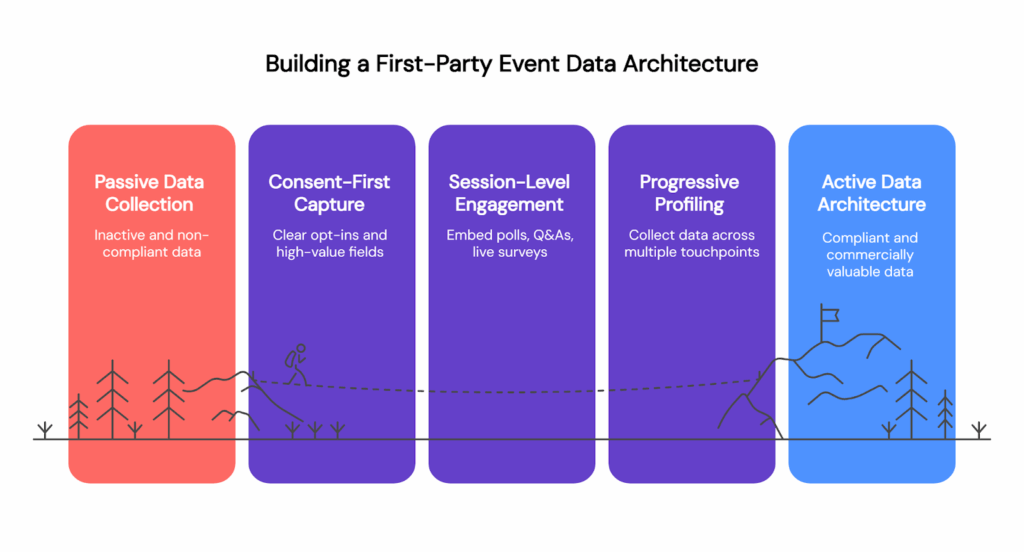For years, B2B events have leaned on digital advertising to justify sponsorship spend. But that world is changing fast. With third-party cookie deprecation looming, the measurement crutches event teams once relied on are vanishing. Google cookies, specifically Chrome cookies, were scheduled to disappear in 2024, only to be delayed once again. Some headlines even read, “Google abandons cookie deprecation,” but the reality is murkier. The company has extended timelines before and may do so again. At the risk of sounding cliche, for now, the only certainty is uncertainty.
For commercial directors and sponsorship leads, this presents a fundamental challenge. Sponsors don’t buy uncertainty; they buy results. If your team can’t prove ROI with data that withstands a cookieless world, budgets will go elsewhere. That’s why now is the time to build a first-party data strategy that doesn’t rely on 3rd party cookies, Google sandbox experiments, or shifting timelines around Google cookie deprecation.
This playbook is designed to help you do exactly that.
Why First-Party Data is the New Sponsorship Currency
In B2B event marketing, sponsors want measurable outcomes. “Reach” used to be enough. Today, it isn’t. With 3rd party cookie deprecation stripping away cross-site tracking, the only sustainable path forward is consented, first-party data.
According to Cvent, 71% of event organizers rank measuring ROI as their top priority. That priority only intensifies as third-party tracking fades. When sponsors ask, “Who did we reach, and how do we know they’re relevant?”, first-party data for events is the only answer that holds up. A Forrester-cited study found that businesses using first-party data strategies experience a 2× increase in conversion rates and a 30% reduction in customer acquisition costs, proving that quality data ‘owned by you’ drives real results
Events are uniquely positioned for this shift: attendees register, opt-in, interact, and engage on platforms owned by organizers. Every interaction is a data signal waiting to be structured into sponsor-ready insights.
Building a First-Party Data Architecture for Events
A winning event data strategy moves beyond passive collection. It’s about actively designing data flows that serve both compliance and commercial value. Here’s the architecture:
- Consent-first capture
- Every registration, gated replay, or award entry should have clear opt-ins.
- Use this moment to capture high-value fields: role, budget influence, and buying horizon.
- Session-level engagement
- Embed polls, Q&As, and live surveys.
- Connect results directly to attendee records to reveal topical interests.
- Progressive profiling
- Collect information in stages across multiple touchpoints.
- Use replay access forms, newsletters, or follow-up surveys to add context without overwhelming attendees upfront.

Why it works: For 56% of marketers, behavior-driven first-party data improved performance marketing; 48% reported better segmentation; and 63 % noted higher customer satisfaction.
- On-site qualification
- Align attendee activity with sponsor categories.
- Example: An attendee who joins the “AI for Finance” workshop, answers a fintech poll, and downloads a compliance whitepaper can be tagged as a high-fit lead for fintech sponsors.
This architecture transforms events into ongoing data engines, every signal consented, every datapoint actionable.
The Commercial Director’s Playbook
Sponsors want more than raw attendance numbers. They want ROI they can defend internally. Here’s how to turn first party data into sponsorship-ready assets:
- Package segmented lists aligned to sponsor verticals.
- Show proof points: engagement reports tied to sessions and booths.
- Build ROI decks with category-level conversion insights.
Instead of selling ‘exposure,’ you sell qualified intent. In the cookie-flux era, that’s the competitive advantage.
Why it matters: Businesses using modern, data-driven strategies are generating 5 to 8× more ROI than those still relying on gut instinct alone.
The 30-Day Implementation Checklist
This is a fast-track plan any event team can roll out in a month, let’s get started:
Week 1: Audit & Alignment
- List all attendee touchpoints where data is captured.
- Identify dependencies on third party cookies or external tracking pixels.
- Review sponsor categories and map what data points would prove ROI for each.
Week 2: Consent-First Capture
- Update registration and awards forms with explicit consent.
- Add opt-in fields for sponsor-aligned interests.
- Implement cookie banners that clarify the shift to first party data.
Week 3: Progressive Profiling & Engagement Layering
- Add session-level polls and embed surveys in breakout rooms.
- Require gated replay access to capture additional qualifiers.
- Integrate progressive profiling into newsletters and post-event resources.
Week 4: Dashboards & ROI Packaging
- Build reporting dashboards showing sponsor match rates, poll participation, and conversion ratios.
- Share early reports internally to stress-test metrics before showing sponsors.
- Define KPI guardrails (below) and lock them into sponsorship decks.
| Week | Focus Area | Action Steps | Output |
| Week 1 | Audit & Alignment | – Map all attendee data touchpoints (registration, awards, replays, etc.) – Identify dependencies on third party cookies / tracking pixels – Align sponsor categories with required datapoints |
Clear picture of cookie reliance + sponsor data needs |
| Week 2 | Consent-First Capture | – Add explicit opt-in to all registration/awards forms – Create sponsor-interest fields (job role, budget, verticals) – Update cookie banner to highlight first party data use (Source: CookieYes) |
Opt-in ready registration forms + cookie-compliant event site |
| Week 3 | Progressive Profiling & Engagement | – Launch live polls, Q&As, and breakout surveys – Gate replays/on-demand access with minimal qualifiers – Embed profiling into post-event comms (newsletters, follow-ups) | Layered attendee profiles with category-level interest signals |
| Week 4 | Dashboards & ROI Packaging | – Build sponsor dashboards (attendee match rates, poll participation, conversions) – Stress-test reports internally – Lock KPI guardrails into sponsor pitch decks |
Sponsor-facing proof of ROI, ready for renewal discussions |
KPI Guardrails for Event Teams
To keep data honest and valuable:
- Consent rate % (attendee opt-ins vs. registrants).
- Attendee-to-qualified-lead conversion %.
- Sponsor category match rate (attendees mapped to sponsor interests).
- Engagement-to-pipeline ratio (signals converted into business outcomes).
- Repeat engagement rate from first party data touchpoints.
These are the guardrails that convert raw data into trusted sponsorship currency.
Why Resilience Matters
The timeline for 3rd party cookie deprecation has already shifted multiple times. Whether Google abandons cookie deprecation again or delays it further, betting your sponsorship strategy on Google cookies is a losing play.
The Google sandbox initiative is still in pilot, and regulators continue to scrutinize it. That makes resilience the only safe strategy, and resilience pays off. Brands using first-party data see up to 8× return on ad spend and 25 % lower cost per acquisition.
Wrapping Up
In a world where Google cookie deprecation keeps shifting, one truth remains: relying on 3rd party cookies is no longer safe. The event teams that thrive will be those who treat first party data as a product, capturing it, packaging it, and selling it to sponsors as proof of ROI.
Sponsors aren’t just buying presence at B2B events anymore. They’re buying certainty. And in a cookieless future, certainty comes only from the data you own.
FAQs
- What is first-party data in B2B events?
First-party data is information collected directly from attendees through registrations, polls, surveys, and replays during B2B events. Unlike third-party data, it is consented, accurate, and highly valuable for proving sponsorship ROI. - Why is third-party cookie deprecation important for event marketing?
With third-party cookie deprecation, event teams can no longer rely on external tracking to measure sponsor ROI. This makes building a first-party data strategy essential for survival in B2B event marketing. - Will Google abandon cookie deprecation completely?
There’s speculation that Google abandons cookie deprecation due to regulatory and technical delays, but experts agree 3rd party cookies will eventually be phased out. Event teams should not wait; the smart move is to plan for a cookieless future now. - What is Google Sandbox, and why does it matter for events?
The Google sandbox (part of the Privacy Sandbox) is Google’s set of alternatives to Chrome cookies for privacy-safe ad targeting and measurement. While useful for advertisers, event marketers can’t depend solely on it. First-party data ensures sponsorship ROI regardless of Sandbox performance. - How can first-party data improve event sponsorship ROI?
By linking attendee engagement, such as session attendance, polls, or downloads, to sponsor categories, first-party data gives sponsors proof of qualified intent. This moves sponsorship ROI beyond impressions and into measurable business outcomes. - What is the best way to collect first-party data at B2B events?
The most effective methods include: consent-first registrations, session-level polls, progressive profiling on replays, and on-site qualification tied to sponsor categories. These methods ensure compliance while delivering rich insights. - How do I future-proof my event strategy in a cookieless world?
Shift from relying on Google cookies or third-party tracking toward first-party data ownership. Implement consent-first capture, profiling, and sponsor-ready reporting so your ROI measurement is resilient even if timelines for Google cookie deprecation shift again. - What are the KPIs to measure B2B event ROI?
Key metrics include: consent rate, attendee-to-qualified-lead conversion, sponsor match rate, engagement-to-pipeline ratio, and repeat engagement. These KPIs help prove sponsorship value without relying on 3rd party cookies. - How to explain B2B event marketing to sponsors?
B2B event marketing is the practice of using events, live, virtual, or hybrid, to generate qualified business leads. Sponsors care less about impressions and more about measurable engagement, which is why first-party data is the strongest currency for these partnerships. - How to see cookies in Chrome?
In Chrome: Settings → Privacy & Security → Site Settings → Cookies and site data. Here you’ll see first-party data and third-party cookies stored on your browser. - How to measure event ROI?
Collect first-party data through registrations, polls, and replays. Map this to sponsor categories. Then measure conversion: how many engaged attendees turned into leads or pipeline. Use KPIs like match rate and engagement-to-pipeline ratio for accuracy. - What is B2B event marketing?
It’s the use of B2B events, conferences, awards, webinars, and exhibitions to engage business buyers. In a cookie-less world, B2B event marketing has shifted toward building measurable intent signals through first-party data.


